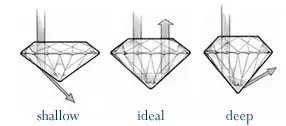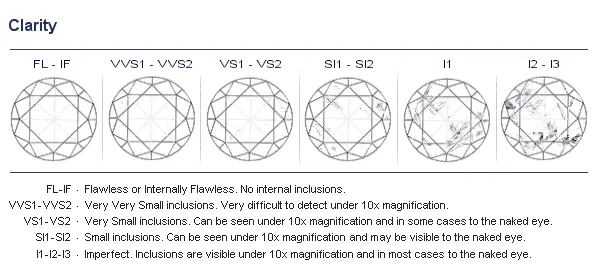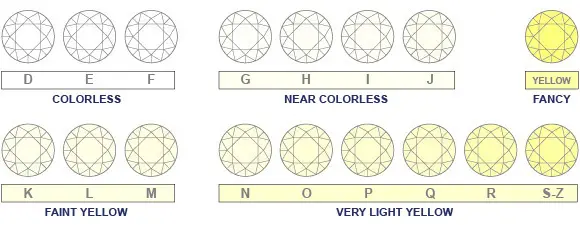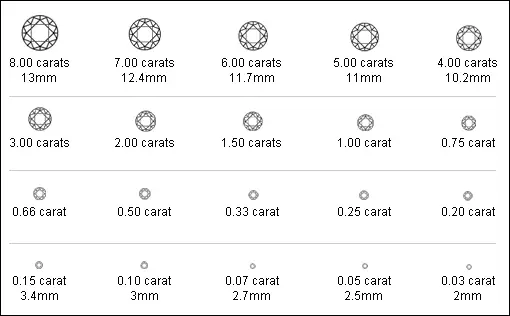Diamond Cut Basics
The cut of a diamond determines that diamond’s brilliance. There is no single measurement of a diamond that defines its cut, but rather a collection of measurements and observations that determine the relationship between a diamond’s light performance, dimensions, and finish.
Most gemologists consider a diamond’s cut to be its most important characteristic. Even if a diamond has perfect color and clarity, a diamond with a poor cut will always have dulled brilliance. This is because the diamond’s width and depth effect how light travels within the diamond and how it exits in the form of brilliance.
Too Shallow – Light is lost from the bottom.
Too Deep – Light escapes from the sides.
Ideal Cut – Maximum sparkle!

Fancy Cut Diamonds
Fancy cut diamonds provide a variety of options that differ from the traditional round brilliant cut. The preferred shape of your diamond is a personal decision, and the experts here at Isbell Jewelers can help you decide which cut inspires you. The proportions for fancy cuts are as unique as the individual who chooses to wear them. There is a myriad of combinations that can make for beautiful designs. Below is a selection of the most popular fancy cut diamond choices.

Diamond Clarity Basics
Clarity refers to the presence of inclusions, or impurities, in a diamond. Inclusions are natural identifying characteristics such as minerals or fractures that appear while diamonds are being formed. They may look like tiny crystals, clouds, or feathers.
The position of these inclusions can greatly affect the value of a diamond. Some inclusions can be hidden by a mounting, so they have little effect on the beauty of a diamond. On the other hand, inclusions in the middle or top of a diamond could impact the dispersion of light, making the diamond less brilliant.
Inclusions are ranked on a scale of perfection known as the clarity scale. The scale ranges from F (Flawless) to I (Included) and is based on the visibility of inclusions. Each basic grade is followed by a number (1-3) to indicate the severity of the inclusions.
The basic rule of thumb is if you can see an inclusion with your naked eye, then it is an “I” grade stone. If you can’t see an inclusion with your naked eye, it is typically either an IF, VS, or SI grade stone and will need to be viewed at 10x magnification to further determine the grade.
If you can easily see an inclusion with a 10x magnification loupe, the diamond likely falls somewhere into the SI grade. If a 10x magnification doesn’t show the diamond’s inclusion, then you’ll need further magnification to narrow the grade to VS or IF.

Diamond Color Basics
Color refers to how colorless a diamond is. The farther from colorless that a diamond’s grade is, the less rare and therefore less valuable it is.
Acting as a prism, a diamond can divide light into a spectrum of colors and reflect this light as colorful flashes called “fire”. The less color in a diamond, the more colorful the fire and the better the overall color grade.
Diamonds are graded on a color scale established by the Gemological Institute of America. The scale ranges from D (Colorless) to Z (Light Yellow). Icy winter whites (D-I) look stunning in white gold or platinum settings. Warmer colored diamonds (J-Z) are typically more desirable when set in yellow gold.
Color differences in diamonds can be very subtle. Grading is done under controlled lighting and compared against a ‘master’ for accuracy. The color chart below is representative of the color grades of a diamond.

Carat Size Explained
A carat is the unit of measurement used to specify a diamond’s weight. One carat is equal to 200 milligrams.
A .75 carat diamond is equivalent to 75 points, or a 3/4 carat diamond. Larger diamonds are found less frequently in nature, so they’re usually more valuable. A 1-carat diamond will often cost more than twice as much as a 1/2 carat diamond, assuming other characteristics are similar.
The most important thing to remember when it comes to a diamond’s carat weight is that it’s not the only factor that determines a diamond’s value. The diagram below shows various carat weights in relation to each other.

